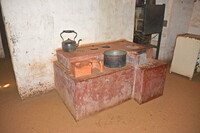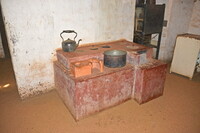| dc.coverage.spatial | Site: Loutolim, Goa, India | en_US |
| dc.coverage.temporal | ca. 1765 (creation) | en_US |
| dc.creator | unknown (Portuguese) | en_US |
| dc.date | 1765 | en_US |
| dc.date.accessioned | 2016-06-21T19:09:49Z | |
| dc.date.available | 2016-06-21T19:09:49Z | |
| dc.date.issued | 1765 | en_US |
| dc.identifier | 264538 | en_US |
| dc.identifier.other | archrefid: 3370 | en_US |
| dc.identifier.uri | http://hdl.handle.net/1721.3/180596 | |
| dc.description | Interior, kitchen area with one of several wood-fired stoves; This house is a remnant of the Portuguese era which began in 1510. After India gained independence from the British in 1947, India requested that Portuguese territories on the Indian subcontinent be ceded to India. Portugal refused to negotiate, but in a military action in 1961, India annexed Goa. Now an historic house museum, the house was most recently owned by Dr. Salvador Eufemiano Araujo Alvares, a prominent lawyer. Source: Wikipedia; http://en.wikipedia.org/wiki/Main_Page (accessed 8/25/2015) | en_US |
| dc.format.medium | brick; wood; stucco | en_US |
| dc.rights | © Scott Gilchrist, Archivision, Inc. | en_US |
| dc.subject | architecture | en_US |
| dc.subject | genre | en_US |
| dc.subject | Housing | en_US |
| dc.subject | Portuguese Colonial | en_US |
| dc.title | Casa Araujo Alvares | en_US |
| dc.type | image | en_US |
| dc.rights.access | Licensed for educational and research use by the MIT community only | en_US |
| dc.identifier.vendorcode | 1A2-IN-G-AH-A12 | en_US |
| vra.culturalContext | Indian (South Asian) Portuguese | en_US |
| vra.technique | construction (assembling) | en_US |
| vra.worktype | house | en_US |
| dc.contributor.display | unknown (Portuguese) | en_US |

